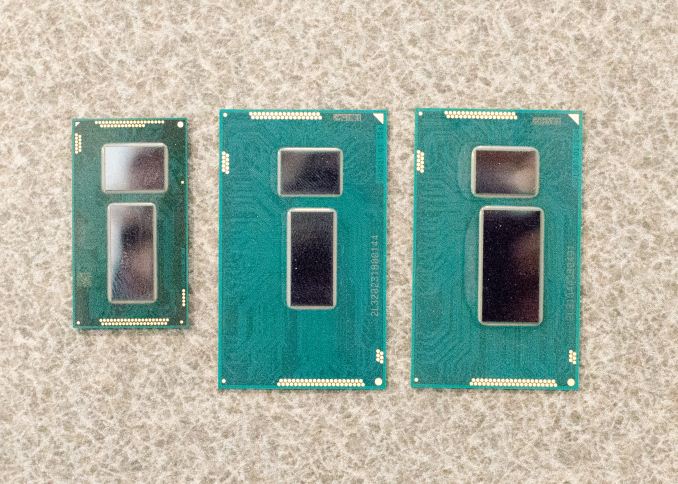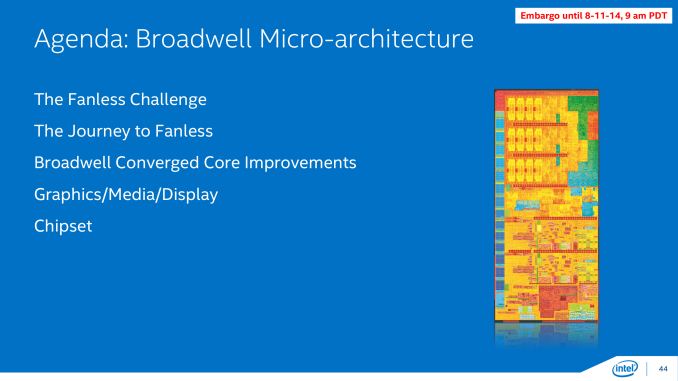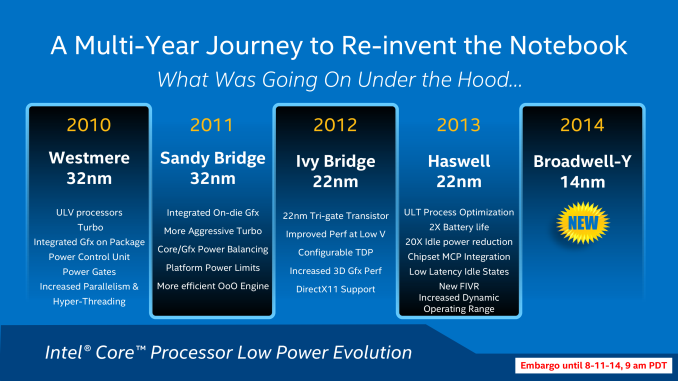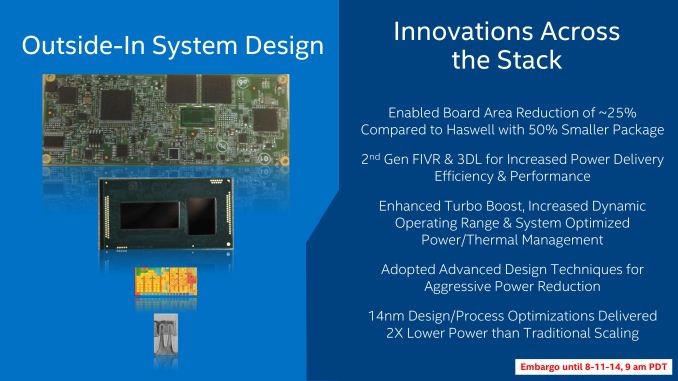Intel Broadwell Architecture Preview: A Glimpse into Core M
by Ryan Smith on August 11, 2014 12:01 PM EST
With Haswell Refresh fully behind us and 2014 now in to its second half, Intel is turning their attention to their next generation of products and processes. Intel’s tick-tock methodology coupled with the long development periods of new products means that the company has several projects in flight at any given time. So while we have seen the name Broadwell on Intel’s roadmaps for some time now, the reality of the situation is that we know relatively little about Intel’s next generation architecture and the 14nm process that it is the launch vehicle for.
Typically we would see Intel unveil the bulk of the technical details of their forthcoming products at their annual Intel Developer Forum, and with the next IDF scheduled for the week of September 9th we’ll see just that. However today Intel will be breaking from their established standards a bit by not waiting until IDF to deliver everything at once. In a presentation coinciding with today’s embargo, dubbed Advancing Moore’s Law in 2014, Intel will be offering a preview of sorts for Broadwell while detailing their 14nm process.
Today’s preview and Intel’s associated presentation are going to be based around the forthcoming Intel Core M microprocessor, using the Broadwell configuration otherwise known at Broadwell-Y. The reason for this is a culmination of several factors, and in all honesty it’s probably driven as much by investor relations as it is consumer/enthusiast relations, as Intel would like to convince consumer and investor alike that they are on the right path to take control of the mobile/tablet market through superior products, superior technology, and superior manufacturing. Hence today’s preview will be focused on the part and the market Intel feels is the most competitive and most at risk for the next cycle: the mobile market that Core M will be competing in.
To that end Intel’s preview is very much a preview; we will see bits and pieces of Broadwell’s CPU architecture, GPU architecture, and packaging, along with information about Intel’s 14nm process. However this isn’t a full architecture preview or a full process breakdown. Both of those will have to wait for Intel’s usual forum of IDF.
Diving into matters then, Core M will be launch vehicle for Broadwell and will be released for the holiday period this year. In fact Intel is already in volume production of the Broadwell-Y CPU and production units are shipping to Intel’s customers (the OEMs) to begin production and stockpiling of finished devices for the holiday launch.
Intel’s decision to initially focus Broadwell on the mobile market comes as the company takes the next step in their plan to extend into the Core processor series into these devices. Arguably, Intel has been slow to response to the rise of ARM devices, whose rapid rise has undercut traditional PC sales and quickly become the biggest threat to Intel’s processor dominance in some number of years. Intel is far from doomed right now, but even they see the potential farther down the line if they do not act.
Intel for their part has responded, but it has taken a step-by-step (multi-year) process that has seen the company progressively build smaller and less power hungry CPUs in order to fit the needs of the mobile market. Since Intel integrated their graphics on-die with Sandy Bridge in 2011, the company has continued to tweak the designs of their products, with Ivy Bridge and Haswell generation products introducing further optimizations and new manufacturing processes. Now on their latest iteration with Broadwell, the company believes they’re turning a corner and have the technology they need to be a leader in the high performance mobile market. It's important to note that despite Intel's best intentions here, Broadwell and Core M remain targeted at premium devices. You won't see these parts in cheap tablets. The duty of doing battle with ARM remains Atom's alone.
Many of these changes ultimately amount to boosting performance and reducing power consumption to a point where power and heat are where they need to be for mobile form factors, either through process efficiency improvements or through better power management and wider dynamic ranges – boosting where it matters and doing a better job of idling between tasks. However as Intel has discovered they not only need to be able to meet the TDP requirements of a tablet but they need to be able to meet the size requirements too. A particularly daunting task when the entire thickness of a device needs to be under 10mm, and the CPU thinner yet.
As a result, coupled with Core M’s performance improvements and power reductions is a strong emphasis on the size of the processor package itself and what Intel could do to reduce it. Intel calls this an outside-in system design, with various parts of Intel focusing on everything from the size of the logic board needed to hold the processor to the thickness of the processor die itself. In the following pages we’ll take a look at Intel’s efforts to get slim, but to kick things off we have a picture of Broadwell-Y from Computex 2014.

From left to right: Broadwell-Y (Core M), Broadwell ULT/ULX and Haswell ULT/ULX
Intel wants a greater foothold in the mobile market and they want it badly. And with Broadwell-Y they believe they finally have what they need to accomplish that goal.














158 Comments
View All Comments
sherlockwing - Monday, August 11, 2014 - link
Tskin=41C?!? Is Intel out of their mind? Did they not read how much trouble iPad 3 got into for a Tskin of 33.6C? http://www.theguardian.com/technology/2012/mar/20/...I hope they/OEMs do keep Tskin undercontrol with better throttling when actually shipping these chips in products.
ZeDestructor - Monday, August 11, 2014 - link
People are cool with high TSkins on their devices. I know my phone passes 35°C easily if I load it up, and I'm fine with that. Then again, I'm completely fine with a 60°C idle, because that's where ICs like to live...Gondalf - Saturday, August 23, 2014 - link
Ummmm present iPad Air scores a 42.1°C skin temperature with an A7 running inside.So not a concern, all recent tablets are pretty hot.
magnusmundus - Monday, August 11, 2014 - link
Looking forward to seeing benchmarks and desktop 14nm parts.Also, I found a typo on the closing thoughts page "Though laptops at a category" should be "Though laptops as a category"
DanNeely - Monday, August 11, 2014 - link
I'm surprised they didn't move the PCH to 22nm. Relatively low power consumption or not, they pushed everything else to the wall to get Core M's TDP as low as possible and between doing custom designs for it anyway and soft sales meaning they've got the spare 22nm capacity available I don't see any obvious reason why they couldn't've done so.klmccaughey - Monday, August 11, 2014 - link
Vastly diminishing returns for the expense seem the most likely answer to that.mkozakewich - Thursday, August 14, 2014 - link
The process nodes are very expensive to produce, so they need to get as much life out of them as possible. Also, a new(er) process isn't going to have a high enough yield. 22 Might have worked, but I bet the older process gave them a better bang for their buck.Flunk - Monday, August 11, 2014 - link
I was thinking of buying one of these, but it sounds like the focus is still on TDP over all else so it looks like waiting to Skylake is the plan for anyone with Sandy Bridge or newer.klmccaughey - Monday, August 11, 2014 - link
Yup :( Is there no hope for us gamers?wurizen - Monday, August 11, 2014 - link
i think AMD is your hope. if you don't have a sandy bridge cpu or in phenom land, an FX series cpu is a great cpu that will hold one over until AMD updates their desktop FX series line of cpu's. i mean a 990FX mobo has all you need. i think pci 2.0 is still adequate for today's video cards so that doesn't really matter. even though on paper, intel has pci 3.0 and usb 5.0 (just kidding) and thunderbolt 9.9, they're superflous and doesn't make you game better. i mean, an fx-8350 with a decent gpu should give one smooth framerates. i mean who cares if in the benchmark, an fx-8350 with so and so gpu will run so and so game at, say 120fps, while an intel chip will run it at 190fps? 120 fps is like very good and that person who has an intel chip running 190 fps probably paid hundreds of dollars more for their system and i bet they wouldn't be even to decipher those 70 or so of more frames. i mean, it's not total fps that matters but the average frame rate and i think an fx-8350 will deliver that. it's a beast of a cpu. and broadwell? who cares. 90% of the words in the article above are buzz tech fancy words to get gadget heads salivating and stock wigs greasing their palms.